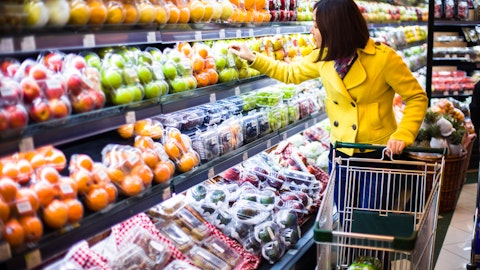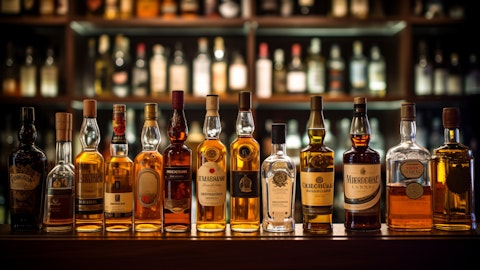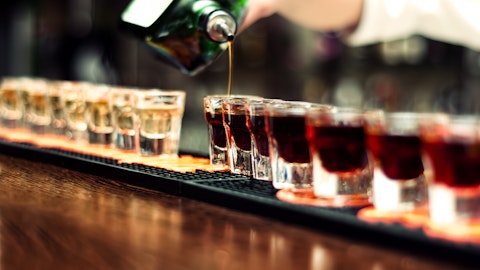Constellation Brands, Inc. (NYSE:STZ) Q3 2024 Earnings Call Transcript January 5, 2024
Constellation Brands, Inc. beats earnings expectations. Reported EPS is $3.19, expectations were $3.03. STZ isn’t one of the 30 most popular stocks among hedge funds at the end of the third quarter (see the details here).
Operator: Greetings. Welcome to the Constellation Brands Third Quarter Fiscal Year 2024 Earnings Call. At this time, all participants are in a listen-only mode. A question-and-answer session will follow the formal presentation. [Operator Instructions] Please note this conference is being recorded. I will now turn the conference over to your host, Joseph Suarez, Senior Vice President of Investor Relations. Thank you. You may begin.
Joseph Suarez: Thank you, Darryl. Good morning all and happy new year. Welcome to Constellation Brands Q3 fiscal ’24 conference call. I’m here this morning with Bill Newlands, our CEO, and Garth Hankinson, our CFO. As a reminder, reconciliations between the most directly comparable GAAP measures and any non-GAAP financial measures discussed on this call are included in our news release or otherwise available on the company’s website at www.cbrands.com. Please refer to the news release and Constellation’s SEC filings for risk factors, which may impact forward-looking statements made on this call. Following the call, we’ll also be making available in the Investors section of our company’s website, a series of slides with key highlights of the prepared remarks shared by Bill and Garth in today’s call.
Before turning the call over to Bill, in line with prior quarters, I’d like to ask that we limit everyone to one question per person, which will help us to end our call on time. Thanks in advance. And now, here’s Bill.
Bill Newlands: Thank you, Joe, and congratulations on your recent promotion. And good morning all. Happy New Year to everyone, and welcome to our Q3 fiscal ’24 call. I hope you all had a wonderful holiday season and were able to enjoy some of our great products with your family and friends. We have several topics to address on today’s call. So let’s start with the key takeaways for this quarter. First, I am pleased to report that our Beer business again delivered very strong performance that accelerated throughout Q3. We achieved depletion growth of over 8% for our beer portfolio with a particularly outstanding end to the month of November. We led Thanksgiving beer sales in US-tracked channels and continued to see accelerating momentum in the last week of the month, reflecting both ongoing strong consumer demand and restocking after the earlier Thanksgiving holiday this year.
And once again, for another entire quarter, we achieved leading share gains in tracked channels with more than 2 point expansion in the US beer category and a nearly 3 point gain in the higher-end. This marks the 55th consecutive quarter of depletion growth for our Beer business and the 10th leading share gains. Secondly, in line with our consistent disciplined and balanced approach to capital allocation, we executed $215 million of share repurchases in Q3, while maintaining our net leverage ratio excluding Canopy equity and earnings unchanged from last quarter at 3.2 times as well as continuing to deliver cash returns through our dividend and advancing our organic growth investments at our Obregon brewery, a new brewery site in Veracruz to support additional production capacity for our Beer business.
And thirdly, as noted at our recent Investor Day, over the past few months, our Wine & Spirits business, much like others across the industry, has seen a broader marketplace deceleration. In light of these and other near-term headwinds, we are further revising our fiscal ’24 organic net sales guidance for Wine & Spirits to be down 7% to 9% and the operating income guidance for that business excluding gross profit, less marketing of brands divested last year, to be down 6% to 8%, which I will elaborate on shortly. Of course, we are not pleased with these revisions at both our leadership team and our Wine & Spirits teams remain fully committed to improving the performance of this business and to achieving its medium-term targets. In addition, as announced earlier today, Robert Hanson has elected to step down from his role as President of our Wine & Spirits business in a few weeks at the end of the current fiscal year.
We have initiated a process to identify a successor for this role and I will step into lead the Wine & Spirits business in the interim, while of course, retaining my Chief Executive oversight across both the enterprise and our Beer business. Despite these revisions and leadership changes, as noted at our recent Investor Day, we continue to believe that over the medium term, our Wine & Spirits business should accelerate its net sales growth to 1% to 3% and improve operating margins to 25% to 26%, supported by the significant transformation undertaken over the last few years to better align our portfolio with broader consumer-led premiumization trends, expand our omnichannel capabilities and extend into targeted international markets. More importantly, in fiscal ’24, we still expect our enterprise comparable EPS guidance excluding Canopy to remain within our previously stated range of $12.00 to $12.20.
And over the medium term, we continue to expect low double-digit EPS growth as outlined at our Investor Day. Now let’s step through these key points for Q3 in more detail. As noted, our beer team once again delivered remarkable results. Modelo Especial led to charge, achieving a roughly 12% increase in depletions and remained the leading share gaining brand in tracked channel dollar sales, strengthening its position as the number one beer brand in the US market having ultimately achieved that top spot now on a 52-week basis. The broader Modelo brand family also delivered phenomenal results. Cheladas achieved an increase in depletions of approximately 22% year-over-year in Q3. And on a rolling 12-month basis, the combined set of Chelada flavors and pack sizes reached the 20 million case milestone, which is over 350% more than that set of brands was doing just five years ago in fiscal ’19.
Additionally, Modelo Chelada Especial, our original flavor, which was recently launched in a 12-pack 12-ounce format was a top 15 share gainer in Circana in Q3, and we are excited about the opportunities ahead for our new Chelada flavor and pack size additions. Also in the Modelo family, Oro, continued its strong first year of going national with a third quarter as a top five share gainer in the high-end. We look forward to the growth opportunities ahead for Oro as awareness grows and we introduce new pack sizes next fiscal year. Beyond Modelo, our Corona Extra and Pacifico core beer brands continued to perform strongly in Q3. Corona Extra maintained depletion growth at about 1%, while Pacifico delivered an outstanding 19% increase. And on a rolling 12-month basis, Pacifico also reached the 20 million case milestone, double its volume from five years ago.
In addition, both brands remained top 10 share gainers across the entire US beer market in tracked dollar sales. Our beer brands clearly continued to resonate strongly with the consumer, and I’m incredibly proud of and thankful to our entire beer team for their consistently strong execution. With that backdrop, we remain confident in our fiscal ’24 net sales growth guidance of 8% to 9%. And from an operating income guidance perspective, we now expect our beer business to deliver 7% to 8% growth for fiscal ’24 as we realize additional benefits this year from the marketing effectiveness actions discussed during our Investor Day. Over the medium term, we still see significant opportunities to continue to achieve net sales growth of 7% to 9% in our Beer business supported by the fundamental distribution, innovation and demographic drivers, as well as consumer-led trends also discussed at our recent Investor Day, as well as to continue to achieve best-in-class operating margins of 39% to 40% supported by savings and efficiency initiatives across our cost of goods sold, marketing, and broader SG&A.
And last but not least, we continue to support the growth of our Beer business through modular investments in brewing capacity and productivity initiatives to unlock further production upside. Moving on to the Wine & Spirits business. As noted earlier, our Wine & Spirits business is operating amid a broader marketplace deceleration. As we have shared in recent quarters, we are actively working to address mainstream headwinds affecting our two largest volume brands Woodbridge and SVEDKA. However, we anticipate these efforts to extend beyond fiscal ’24. More broadly, while we are maintaining a disciplined approach to taking price across our portfolio, the competitive environment is now getting pressured with more aggressive discounting and price points beyond mainstream.
Again, we believe the broader deceleration in these higher-end categories to be temporary and have continued to execute strategic pricing actions instead of implementing reductions like certain competitors. In addition, we have made the decision to adjust some aspects of our US wholesale distributor agreements focused on improving mix, inventory, and state and channel level sales execution. We are actively engaged with our largest distributor partner to ensure that our portfolio continues to make progress against our vision of leading the higher-end as well as on the revitalization of our mainstream brands. From an international perspective, while we experienced a decline in the quarter driven by previously noted weakness in our more mature markets, inventory levels in Canada, our largest export market, seem to now be normalizing following the destocking from recent changes to inventory regulations.
So we anticipate more balanced supply-and-demand dynamics for this market going forward. Importantly, despite the impact of these near-term headwinds on organic net sales, our prudent pricing and cost efficiency efforts enabled margin improvement for Wine & Spirits in Q3. Beyond these near-term challenges, our focus remains on driving growth across our higher-end brands. As shared during Investor Day, over the last few years, our Wine & Spirits business has established a stronger foundation to advance toward these targets. Since fiscal ’19, we have doubled the number of fine wine and craft spirits brands in our portfolio and we have invested and expanded our footprint in higher-growth DTC channels in targeted international markets. With our structural transformation securely in place, I want to thank Robert Hanson for his contributions over many years including initially as a non-executive member of the Board.
We wish Robert well and all the best in his future endeavors and look forward to announcing the appointment of our next Wine & Spirits business President in the near future. Lastly, I’d like to emphasize again our unwavering commitment to our consistent, balanced, and disciplined approach to capital allocation. As noted at our Investor Day event, we continued to target a strong balance sheet that supports our investment-grade rating and we are working toward a net leverage ratio of 3 times which we expect to achieve within fiscal ’25. We expect to maintain a dividend payout ratio of approximately 30%, supporting continued growth of our dividend per share in line with our earnings expectations. We plan to invest approximately $5 billion in growth and maintenance CapEx from fiscal ’24 to fiscal ’28, primarily focused on brewing capacity expansions for our beer business.

We continue to opportunistically buy back shares with $215 million repurchased in Q3, which leaves us with an additional $2.6 billion still within our existing share repurchase authorization. And finally, we continued to look at tuck-in gap-filling M&A opportunities with a highly rigorous transaction criteria. So to close, let’s go back to the key takeaways for the quarter. First, we have a beer portfolio and team that consistently delivers industry-leading performance and we see significant opportunities as outlined at our Investor Day to continue to drive similarly strong growth over the medium term. Second, we remain committed to delivering value to our shareholders through consistent execution of our balanced and disciplined capital allocation priorities and third, our Wine & Spirits business is focused on realizing net sales growth and improved operating margins by leveraging its reshaped higher-end leaning portfolio as well as our enhanced DTC channel and international market footprints and capability.
And lastly and importantly, we continue to expect our enterprise comparable EPS guidance in fiscal ’24 excluding Canopy to remain within our previously-stated range of $12.00 to $12.20. And over the medium-term, we continue to expect low double-digit EPS growth as we outlined at our Investor Day. And with that, I will now turn the call over to Garth, who will review our financial results in greater detail. Garth?
Garth Hankinson: Thank you, Bill, and good morning, everyone. As usual, my discussion on our financial performance will mainly focus on comparable basis results and stepping through our P&L. However, as of this quarter, we will discuss enterprise results, followed by business segment detail to better address our performance against the outlook shared at our Investor Day at these different levels. Beginning with net sales. We achieved enterprise-wide top line growth of 1% for the quarter. This was the result of solid Beer net sales growth of 4%, partially offset by the Wine & Spirits net sales decline of 8%. Wine & Spirits net sales decline was 7% on an organic basis. As Bill noted, Beer business depletions for the quarter were above 8% as the year-over-year growth momentum from summer continued through the fall, supported by ongoing strong consumer demand of our portfolio.
Again, we saw a particular acceleration in depletion volumes at the end of November as we extended our leadership across key holidays with outstanding performance during US Thanksgiving. Our on-premise channel realized modest growth in depletions of about 1% for Q3 and accounted for approximately 11% of our total volumes as we’ve been able to replenish inventories following the keg disruption over the summer and began to advance growth and drive performance in the on-premise. Shipment volumes for beer business grew 3.4%, and we achieved favorable pricing slightly above 1% as we began to lap the elevated pricing increases from last fall. These volume and pricing uplifts were partially offset by a shift in packaging mix. Altogether, these year-over-year shipment, pricing and mix changes drove the 4% or approximately $77 million increase in beer net sales for the quarter.
For our Wine & Spirits business, organic net sales declined 7%, driven by lower shipment volumes due to the previously referenced category headwinds and the change in our process aimed at aligning shipments and depletions. As a reminder, per prior calls this year, we now make quarterly shipment adjustments to align with depletions versus our former practice of only doing one annual adjustment in the fourth fiscal quarter. We believe this process change has partially driven less favorable comparisons for the first three quarters of fiscal 2024. Now shifting to operating margins. For Q3, enterprise-wide operating income increased 7%, and operating margin increased 170 basis points to 32.3%. This was primarily a result of an increase in operating income of 7% for our Beer business, which also drove a 100 basis point increase in Beer business operating margin to 38.5%.
Enterprise-wide operating margins also benefited from a 13% reduction in corporate expense. These Beer business and corporate expense tailwinds were partially offset by a 5% decrease in our Wine & Spirits business operating income, which still yielded a 60 basis point increase in operating margin to 25.4% for the Wine & Spirits business. Excluding the gross profit, less marketing, of the brands that are no longer part of the business following their divestiture, operating income and operating margin for the Wine & Spirits business decreased by 4% and increased by 80 basis points, respectively. Stepping through these drivers in more detail, starting with beer. The increase in operating income and margin were a result of benefits and cost of products sold as we continue to build cost efficiency and productivity savings.
For the quarter, total cost savings were approximately $55 million. An $11 million or a 6% decrease in marketing costs as a result of shifts in timing of spend. Note that marketing as a percent of net sales was 8.7% for the quarter. A $4 million decrease in SG&A expense, primarily driven by lower legal fees, partially offset by higher compensation and benefit expenses and $6 million of favorability from the divestiture of our craft beer business. These benefits were partially offset by a $12 million unfavorable foreign currency impact as we still realized a higher Mexican peso rate year-over-year, inclusive of our multiyear hedging positions. Additionally, in line with our full year expectations and guidance we are still facing higher costs in our packaging and raw materials, which resulted in a $17 million headwind for the quarter.
We have also faced an $11 million increase in depreciation as a result of our capacity expansions. The reduction in our corporate expense, which for the quarter was $10 million, was primarily driven by the reduction in third-party services, particularly in our digital business acceleration investments partially offset by increased compensation and benefits. Our Wine & Spirits operating income margin, excluding the gross profit less marketing of the brands that are no longer part of the business following last year’s divestiture had a year-over-year improvement as the volume declines and unfavorable mix were more than offset by reduced logistics and warehousing costs, favorable SG&A costs due to reduced third-party consulting expenses and lower compensation and benefits.
More favorable material costs driven by our cost savings initiatives and reduced marketing expense as we continue to shift our marketing focus towards more efficient, high return efforts. Interest expense for the quarter was approximately $104 million, driven by higher average borrowings and higher weighted average interest rates. As a reminder, approximately 5% of our debt obligations are subject to adjustable rates. As Bill noted, we ended the quarter with a net leverage ratio of approximately 3.2 times excluding Canopy equity and earnings and remain on track to reach our target goal of 3 times within fiscal 2025. Our comparable effective tax rate, excluding Canopy equity and earnings for the quarter was 18% versus 18.8% last year. Our comparable EPS for the quarter, excluding Canopy equity and earnings, was $3.24, reflecting the consistent growth of our business and representing an 8% increase.
Moving to free cash flow, which we define as net cash provided by operating activities less CapEx, we generated free cash flow of $1.4 billion through the first three quarters of fiscal 2024 and a 10% decrease driven by a 33% increase in CapEx investments attributable to the expansions at our existing Obregon facility and the construction of our new brewery located in Veracruz. As we look towards the end of fiscal ’24, our guidance for enterprise comparable EPS, excluding Canopy equity and earnings remains unchanged at $12 to $12.20 underpinned by the following expectations. First, an unchanged 8% to 9% net sales growth outlook but a higher 7% to 8% operating income growth expectation for our Beer business. As stated in our prior calls this year and at our recent Investor Day event for our beer net sales, we continue to expect pricing to be between 1% to 2% and mid to high single-digit volume growth in fiscal ’24.
And we still anticipate shipment volumes for the second half to account for approximately 45% of the full year total. Bill already addressed the drivers of the uplift in our beer operating income growth guidance but it’s also important to note that we still expect beer operating margin to be approximately 38% for the full year. Second, for our Wine & Spirits business, we now expect a decline of 7% to 9% in organic net sales and a decline of 6% to 8% in operating income, excluding the impact of the divested wine brands that are no longer part of our results. Bill also already addressed the drivers for these revisions. Third, from a corporate expense perspective, we now expect that to be approximately $260 million to $270 million for the full year which includes a slightly lower end to the range versus our prior expectation.
And similarly, our interest expense expectations are now slightly lower at approximately $450 million. And last but not least, we continue to expect our comparable effective tax rate, excluding Canopy, to be approximately 19% and despite the additional $215 million of share repurchases executed in the third quarter, we also continue to anticipate weighted average diluted shares outstanding to be approximately $184 million. Beyond the P&L, for free cash flow, we expect to be in the range of $1.4 billion to $1.5 billion for fiscal ’24, reflective of $2.6 billion to $2.8 billion in operating cash flow and $1.2 billion to $1.3 billion of CapEx. In closing, we continue to deliver industry-leading results in our beer business and remain confident in our ability to achieve our stated EPS targets for this fiscal year despite incremental category headwinds affecting our Wine & Spirits business.
As we look further ahead, we remain excited about continuing opportunities to build shareholder value over the medium term, which we hope to achieve by capturing the substantial growth opportunities that exist for our Beer business, executing against our consistent, disciplined and balanced capital allocation priorities and delivering enhanced performance in Wine & Spirits, supported by the significant transformation that business has undergone and the actions that we are taking to improve this business. We encourage existing and prospective shareholders who have not yet had an opportunity to review our recent Investor Day presentations to access those through our Investor Relations website, ir.cbrands.com to gain further insights into our medium-term perspective on these topics.
And with that, Bill and I are happy to take your questions.
See also 25 Cities with Highest Female to Male Ratio in the World and Best Car Accident and Personal Injury Lawyers in Each of 30 Biggest Cities in the US.
Q&A Session
Follow Constellation Brands Inc. (NYSE:STZ)
Follow Constellation Brands Inc. (NYSE:STZ)
Operator: Thank you. We will now be conducting a question and answer session. [Operator Instructions] Our first question comes from the line of Nik Modi with RBC Capital Markets. Please proceed with your question.
Nik Modi: Thank you. Good morning, everyone and Happy New Year.
Bill Newlands: Same to you.
Nik Modi: So, Bill, maybe you can provide some context. Obviously, you provided a few intra-quarter updates, one at the Analyst Day and one at the Morgan Stanley conference. Just regarding both the Beer and the Wine & Spirits business and obviously things came out a little bit differently. So I was hoping you can just kind of give us a perspective on what exactly happened to cause some of the delta. And if some of the clarity or perspective you gave us around the gaps between scanner data and your actual results, how we should think about that because I’m sure that’s going to be something we’re all going to have to start thinking about over the next couple of weeks?
Bill Newlands: Sure. Thanks, Nick. And again, Happy New Year to you. As we said in our prepared remarks, we’re obviously very pleased with our Beer business in Q3 and we are particularly happy with the strong acceleration in the momentum that sort of came out of November. Interestingly enough, the delta between Circana and our numbers sort of changed about the minute Garth stopped speaking at the conference in November. So that was always interesting how that works. As we’ve noted, we expect about 45% of our Beer business volumes will be achieved in H2, which is in line with the normal seasonality of that business. And for Q4 specifically, we expect those shipments in depletes will end up being about 20% to 21% of our total fiscal year volumes.
But we also expect that we’re going to continue to drive mid to high single-digit volume growth annually, which is consistent with the depletion performance that we’ve now achieved for over a decade. And again, that’s consistent with what we’ve also said, 1% to 2% annual average pricing increases, which supports the 7% to 9% annual net sales algorithm that we’ve said we will do in the medium term. On the Wine & Spirits side, obviously, we’re further revising our guidance down, was not a decision we took lightly, and we’re certainly not happy about it. We examined numerous scenarios and ultimately determined the adjustment was really needed to reflect a number of things. The broader category deceleration and other factors that affected our performance including gaps from our prior US wholesale expectations that we’re actively addressing with our distributor partners and importantly, while making sure we maintain an appropriate inventory level for the remainder of this year, setting ourselves in good position to see sequential improvement in fiscal ’25.
Of course, as I said, we’re not pleased with these revisions, and neither is our leadership team nor our Wine & Spirits team, but we’re certainly committed to improving that performance in the medium term and expect that our net sales and operating margin targets will be consistent with what we said at Investor Day. As you’ve also seen, I’m going to be temporarily taking over that business, and I will be spending a fair amount of time with the Wine & Spirits division as we work through the process of appointing a new leader, which we have already started considering both internal and external candidates. As you probably know better than many, I spent several years of my career within the Wine & Spirits categories, and I look forward to working more closely with that team in the interim, particularly as that business turns its focus toward enhancing operational effectiveness and marketplace execution to build on the reconstituted higher-end portfolio and organizational structure that we put in place over the last few years.
But ultimately, and I’d like to, Nik, reiterate this one more time. In fiscal ’24, we still expect our enterprise EPS guidance to remain within our previously stated range of $12.00 to $12.20 and over the medium term, we also continue to expect low digit EPS growth, as outlined at Investor Day. Hopefully, that gives you some good perspective on those elements you asked about.
Operator: Thank you. Our next question comes from the line of Bonnie Herzog with Goldman Sachs. Please proceed with your question.
Bonnie Herzog: All right. Thank you. Good morning and Happy New Year, everyone. I wanted to drill down a bit more on your beer margins. Bill and Garth, you raised your fiscal year beer operating income growth guidance. But this does still imply very low op margins in Q4. So I guess I’d like to better understand the drivers of this. And really how much visibility you have in terms of whether it’s your marketing expense or commodities, hedges, et cetera, for the rest of this fiscal year? And then perhaps any color on how margins should be phasing next fiscal year would be helpful. Thanks.
Garth Hankinson: Bonnie, just to start on the question for next fiscal year, obviously, we’ll give guidance on next fiscal year at our next conference call in April. But as it relates to margins this year, I mean, obviously, margins are progressing in line with what our expectations are. And what you saw in the third quarter, this is the first time from a year-over-year perspective where we had margin improvement which again is what we expected at the outset of the year. What we’ve always said about margins is, and this ties back to what we’ve said about volumes and shipments and depletions is 55% of our activity will occur in the first half of the year and 45% in the second half of the year. And in Q4, specific to your question on Q4, that — it’s always typically one of our lower shipping quarters.
And so therefore, margins are lower just by virtue of reduced throughput through our facilities. On top of that, we continue to have increasing depreciation costs that we referenced during our prepared remarks. But as I say, I mean, we do expect that Q4 margins this year will be better than they were of last year, continuing the trend of year-over-year improvement and which, obviously, we feel confident about our ability to get back into our 39% to 40% range as we went into very good detail at our Investor Day.





